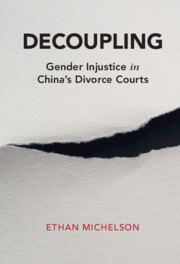Book contents
- Decoupling
- CAMBRIDGE STUDIES IN LAW AND SOCIETY
- Decoupling
- Copyright page
- Dedication
- Contents
- Figures
- Tables
- Preface and Acknowledgments
- CHAPTER ONE Sisyphus Goes to Divorce Court
- CHAPTER TWO The Right to Decouple
- CHAPTER THREE The Divorce Twofer
- CHAPTER FOUR Studying Judicial Decision-Making
- CHAPTER FIVE “Many Cases, Few Judges” and the Vanishing Three-Judge Trial
- CHAPTER SIX Tracing the Origins of the Divorce Twofer to Heavy Caseloads
- CHAPTER SEVEN How Judges Gaslight Domestic Violence Victims in Divorce Trials
- CHAPTER EIGHT Divorce Denials
- CHAPTER NINE Fight or Flight
- CHAPTER TEN Possession is Nine-Tenths of the Law
- CHAPTER ELEVEN Quantitative Patterns in Child Custody Determinations
- CHAPTER TWELVE Conclusions
- References
- Index
- CAMBRIDGE STUDIES IN LAW AND SOCIETY
- References
References
Published online by Cambridge University Press: 24 March 2022
- Decoupling
- CAMBRIDGE STUDIES IN LAW AND SOCIETY
- Decoupling
- Copyright page
- Dedication
- Contents
- Figures
- Tables
- Preface and Acknowledgments
- CHAPTER ONE Sisyphus Goes to Divorce Court
- CHAPTER TWO The Right to Decouple
- CHAPTER THREE The Divorce Twofer
- CHAPTER FOUR Studying Judicial Decision-Making
- CHAPTER FIVE “Many Cases, Few Judges” and the Vanishing Three-Judge Trial
- CHAPTER SIX Tracing the Origins of the Divorce Twofer to Heavy Caseloads
- CHAPTER SEVEN How Judges Gaslight Domestic Violence Victims in Divorce Trials
- CHAPTER EIGHT Divorce Denials
- CHAPTER NINE Fight or Flight
- CHAPTER TEN Possession is Nine-Tenths of the Law
- CHAPTER ELEVEN Quantitative Patterns in Child Custody Determinations
- CHAPTER TWELVE Conclusions
- References
- Index
- CAMBRIDGE STUDIES IN LAW AND SOCIETY
- References
Summary
- Type
- Chapter
- Information
- DecouplingGender Injustice in China's Divorce Courts, pp. 476 - 525Publisher: Cambridge University PressPrint publication year: 2022
- Creative Commons
- This content is Open Access and distributed under the terms of the Creative Commons Attribution licence CC-BY-NC-ND 4.0 https://creativecommons.org/cclicenses/

